The Three Valleys as we know it today is a magnificent resort, with large, well-groomed slopes, countless off-piste routes, fine dining and luxury accommodation, however it has not always been that way. A visitor to the region just fifty years ago would have looked in vain for signs of the modern ski resorts that today attract skiers from all over the world to ski in this remarkable corner of France. Only a collection of small isolated hamlets and chalets would have been found nestling in the high open pastures that were the result of over seven centuries of deforestation by farmers trying to scratch a living from the mountainside. The history of the Three Valleys, and its success, however, have come a long way since its birth some 95 years ago.
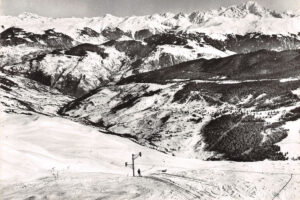
The Three Valleys before development
Tourism has been long established in the region, even before the birth of the famous ski resorts that today we all know and love. In the latter half of the 19th century, the Alps saw the growth of “alpinism” and with the opening of the fashionable spa-towns, during which those of Brides-les-Bains and Salines-les-Thermes, located at the bottom of the valley, gained their reputations. Higher up the mountains the first hotel in Saint Bon was opened in 1908 and, as alpinism was a growing market in the region, the British were never very far away.
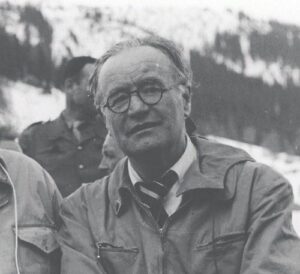
Champion skier and inventor of the slalom, British-born Arnold Lunn helped to scout locations for a new ski resort in the French Alps
In 1925, several British businessmen and experienced skiers wanted to create a resort in France, such as those that already existed in Austria and the Swiss Grisnons. They sought the help of the most senior of British skiers, and inventor of the slalom, Arnold Lunn, to explore the Saint-Bon valley, to look for a site in which they could practice their hobby on a grand scale. Lunn organised a small expedition with Emile Allais (an Olympic medal winner at the 1936 games) and Andre Tournier (a then-famous French mountaineer) to methodically prospect the Dauphinoise and Savoyard Alps and his conclusion was simple “in the Savoie there is an exceptional site that comprises three almost parallel valleys : Saint-Bon, Les Allues and Belleville. In spite of their different features, they lend themselves well to the development of large resorts”.
In 1938, the first hotel in the region was built above the ancient hamlet of Mussillian, and was associated with the Three Valley’s first ski-lift, a 19-seat cable sled called the “Red Dragon”/ Since the name Mussillian was too difficult for prospective British customers to pronounce, it was renamed Meribel.
One of the expedition leaders, the Scottish Major, Peter Linsay, moved to Meribel permanently, where he created the where he created the Société Foncière de la Vallée des Allues, and gradually developed the resort.
In December 1938, the Saint Bon municipal council voted in a land development on the Courchevel and Moriond sites. Even though during the Second World War in 1940, the ski industry came to an abrupt halt, planning nevertheless continued, since the project was privately funded.
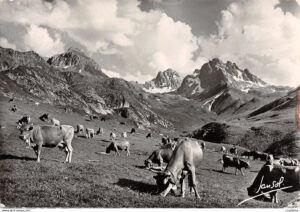
Before tourism, mountain life depended on livestock
And so, the future of the Three Valleys was set. The mountain way of life began change in 1941, when a government commission was organised with a brief to study the requirements for such a resort, and a subsequent 83-page report, published in 1942, proposed the development of purpose-built resorts perched high in the snow fields, an innovation in Europe. These centres for international tourism, they concluded, would help to compete with the then fashionable resorts of Sestrieres in Italy, Sun Valley in the USA and Davos in Switzerland.
The report proposed development in the Three Valleys on the edge of the Vanoise National Park. The area offered a high annual snowfall on north facing slopes to ensure good conditions, as well as many other slopes whose positioning allowed one to “ski in the sun on pistes in the shade”. The terrain was even and uninterrupted, and allowed for a variety of pistes of differing grades as well as suitable flat areas for the construction of ski villages.
The original plan was to commence in the Belleville Valley where Les Menuires now stands, with later development around Meribel and finally Courchevel in the Saint-Bon valley. However, local opposition prevented building in the Belleville Valley and the initial development in Meribel collapsed from a lack of funds. The first operational ski lifts finally opened in Courchevel in 1946.
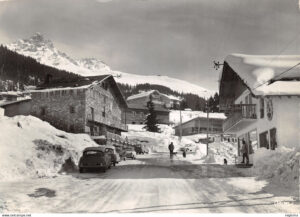
The ski-resort of Méribel in 1969
The development of Meribel as we know it owes much to two French architects, Christian Durupt and Paul Jacques Grillo. Together with Peter Linsay, they felt it essential to maintain the existing authenticity of the Savoyard resort and as such only wood and stone were used for the main body of the Meribel ski chalets and mountain slate for the sloping roofs. To this day Meribel chalets owe their beauty and charm to such foresight, and it is this above all that sets it aside from the majority of purpose built resorts.
During the summer and autumn of 1946, the Courchevel – Les Tovets draglift was commissioned and in 1947 the Les Tovets- La Loze lift was inaugurated, making Courchevel the first linked resort town in the Three Valleys. From then, things moved relatively quickly, with the opening of the Hotel Departmental des 3 Vallées and the Hotel de la Loze in January 1948.
The resort needed a name, and a young French architect, Laurent Chappis, who had drawn up plans for three interconnected ski resorts in the area before the war, wanted it to remain the ‘Plateau des Tovets’. Others in the resort, however, felt a new resort needed something punchier. Pierre de la Gontrie suggested Courchevel, the name of a hamlet situated someway down the mountain, and subsequently passed the idea past the mayor of which the commune was situated. .The mayor was not opposed to the idea, and it was therefore decided that the hamlet of Courchevel’s name would be changed to Courchevel-Dessous (Lower Courchevel) to avoid confusion to would-be tourists. However, despite being few in number, some residents were infuriated and felt the name implied the were situated much further down, and the community feared they would lose out on the tourism boom. The matter was resolved with the real Courchevel being called Courchevel 1550, and the Plateau des Tovets was named Courchevel 1850.
But now, the development of the Three Valleys had turned its attention to another project to connect the resorts – the Haut-Tarentaise and the Maurine, by ski lifts with extensions to Chamonix and Briaçon. In December 1951, Courchevel was connected to the Allues valley, via the Burgin-Saulire lift.
At this time, the Allues valley was in the early stages of developing the new resort Meribel and with three draglifts already in operation, the valley gained electricity for the first time. By August 1952, the Saulire cable car was being constructed and in November 1954, Emille Allais took of the management of Courchevel 1850.
By 1958, the first Three Valleys ski-passes were sold and, following the immediate success of Courchevel, the resort of Les Manures was developed in the 1960s and 1970s. The result, a classic example of quick-build architecture that can be found in so many ski resorts across France, was not welcomed with as much fanfare as the resorts of Meribel and Courchevel, and so recently new construction has been carefully reviewed to create an Alpine atmosphere, with sensitive use of wood and stone.
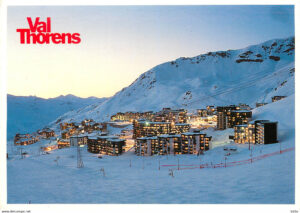
A postcard showing Val Thorens shortly after its completion
During the winter of 1972-73, Val Thorens was being developed at the door the glaciers, 2,300 metres above sea-level. In 1983, Saint Martin de Belleville was developed as part of the Three Valleys network of ski-slopes, and it was’t until the 1990s that other, smaller resorts were developed in the region, such as the once little hamlet known as La Tagna. December 1990, “La Tania” was opened to the public, in which the architect Jacques Labro and his team had worked hard to preserve this beautiful location by using perfectly integrated construction methods, and by using wood and traditional materials wherever possible. In February 1992, the Winter Olympics were held at Albertville, at the base of the valley, and helped to make the Three Valleys world-famous.



